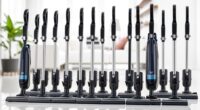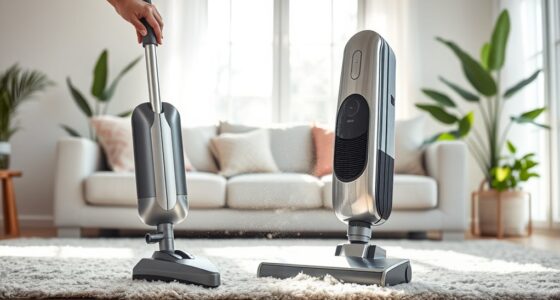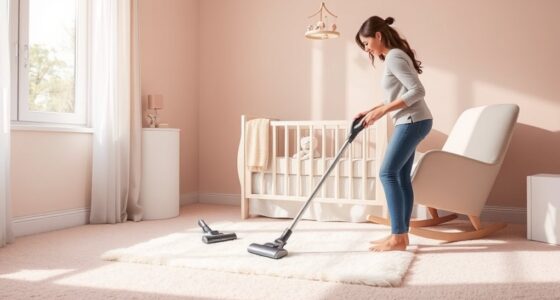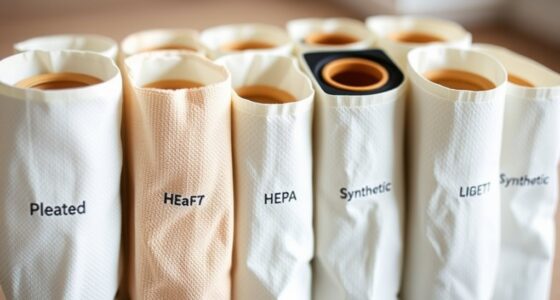Vacuuming with a HEPA filter can help reduce indoor mold spores by capturing tiny particles like mold as small as 0.3 microns, preventing them from recirculating into the air. However, it isn’t enough on its own to eliminate mold—regular cleaning, moisture control, and addressing underlying issues are also necessary. If you want to learn more about effective mold management and the best practices, keep exploring these important details.
Key Takeaways
- Proper vacuuming with HEPA filters can reduce airborne mold spores when done regularly and correctly.
- Vacuuming targets surfaces like carpets and upholstery, helping lower spore accumulation.
- It is most effective when combined with moisture control and surface cleaning in a comprehensive mold prevention plan.
- Regular maintenance of vacuum filters and canisters prevents spores from being recirculated into indoor air.
- Vacuuming alone cannot eliminate mold; addressing moisture issues and cleaning surfaces are essential for effective mold control.
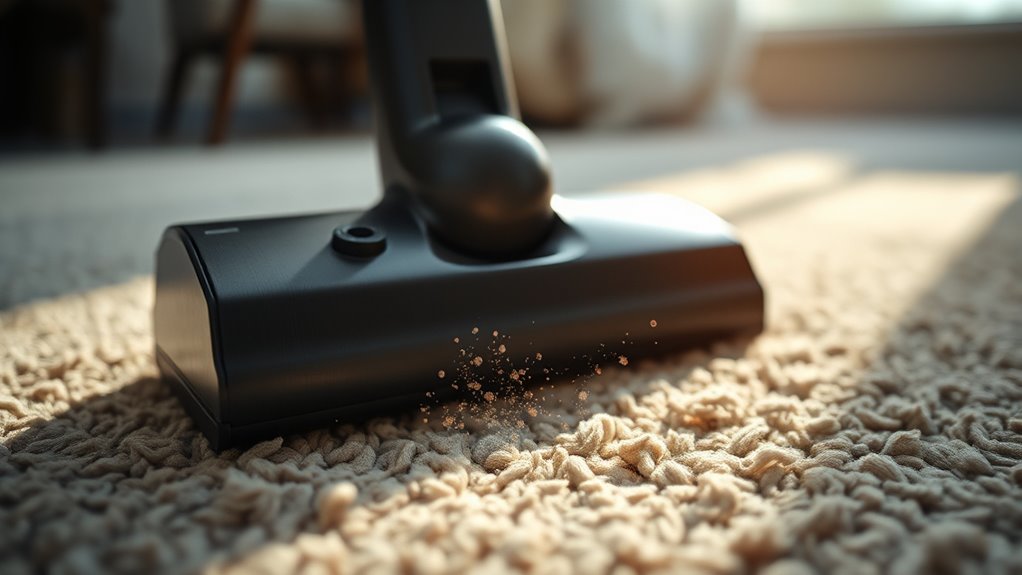
Vacuuming is a common method for cleaning indoor spaces, but it can also influence the presence of mold spores inside your home. When done correctly, it may help reduce the number of airborne mold spores, but it’s not a complete solution on its own. The effectiveness of vacuuming depends heavily on factors like air filtration and cleaning frequency. If your vacuum cleaner has a high-efficiency particulate air (HEPA) filter, it can trap tiny mold spores more effectively than standard filters. These filters are designed to capture particles as small as 0.3 microns, which includes many mold spores, preventing them from recirculating into the air. Using a vacuum with good air filtration means you’re actively removing spores from surfaces and reducing their presence in the air, which can be especially beneficial in areas prone to moisture or mold growth.
However, simply vacuuming more often isn’t always enough. Regular cleaning frequency plays a *vital* role in controlling mold spores indoors. If you vacuum infrequently, mold spores that settle on surfaces can accumulate and later become airborne when disturbed. This means that keeping a consistent cleaning schedule—preferably at least once a week—can *considerably* lower the chances of spores becoming airborne and spreading throughout your home. It’s important to vacuum all surfaces, including carpets, upholstery, and curtains, because mold spores tend to settle on these areas. Ignoring these surfaces could allow spores to build up over time, increasing the risk of mold-related health issues. Additionally, understanding the role of sleep and mental health in overall well-being can improve your motivation for maintaining a healthy indoor environment.
Moreover, vacuuming should be part of a broader mold prevention strategy. Addressing moisture problems, improving ventilation, and cleaning surfaces with mold-killing solutions are essential steps. Vacuuming alone won’t eliminate mold growth if underlying issues like leaks or high humidity aren’t addressed. When vacuuming, you should also be cautious about the direction of airflow—vacuuming in one room and then another without changing filters or cleaning the vacuum can spread spores around. Always empty your vacuum’s canister or replace its bag regularly to prevent spores from escaping back into your home environment.
Frequently Asked Questions
How Often Should I Vacuum to Control Mold Spores Effectively?
You should vacuum regularly to support mold control in your home. For effective mold spore management, aim for a vacuum frequency of at least two to three times a week, especially in high-risk areas like bathrooms and basements. Consistent vacuuming helps remove mold spores from surfaces and reduces airborne particles. By maintaining this routine, you actively contribute to a cleaner, healthier environment and prevent mold from spreading further.
Are HEPA Vacuum Cleaners Necessary for Mold Spore Removal?
You might think regular vacuums are enough, but HEPA filtration vacuums are essential for mold spores. They trap tiny particles that standard vacuums miss, preventing spores from recirculating. Proper vacuum maintenance guarantees maximum performance, so investing in a HEPA vacuum helps control indoor mold spores effectively. Without it, spores can linger, making your efforts less effective. Prioritize HEPA filtration and regular vacuum maintenance to protect your indoor air quality.
Can Vacuuming Alone Eliminate All Indoor Mold Spores?
You can’t rely on vacuuming alone to eliminate all airborne spores or prevent mold growth. While regular vacuuming, especially with a HEPA filter, helps reduce surface mold spores, it doesn’t fully remove airborne spores embedded deep in materials or hidden areas. To effectively control indoor mold, you need a thorough approach that includes fixing moisture issues, proper ventilation, and professional mold remediation if necessary.
Does the Type of Flooring Affect Mold Spore Removal via Vacuuming?
You should consider how your flooring material affects vacuum compatibility when aiming to remove mold spores. Hard surfaces like tile or hardwood allow for more effective vacuuming, as spores are easier to pick up and don’t hide in fibers. On the other hand, carpets may trap spores deeper within their fibers, making vacuuming less effective. Choosing the right vacuum for your flooring material can help improve mold spore removal.
Are There Specific Vacuuming Techniques to Maximize Mold Spore Removal?
Imagine you’re tackling mold spores deep in carpet fibers. To maximize mold spore removal, use vacuuming techniques like slow, overlapping passes and a vacuum with a HEPA filter. Focus on thorough coverage, especially in corners and under furniture. Regularly change filters and empty the canister. These steps guarantee you effectively lift mold spores, reducing indoor mold growth and improving air quality.
Conclusion
So, while vacuuming might not wipe out every trace of mold, it certainly helps keep those pesky spores at bay. Think of it as a gentle nudge toward a healthier home, where your indoor air feels fresher and safer. Regular cleaning invites a subtle change, making your space less inviting for mold to settle in. Embrace these small steps—they might just make a big difference in your indoor environment.

